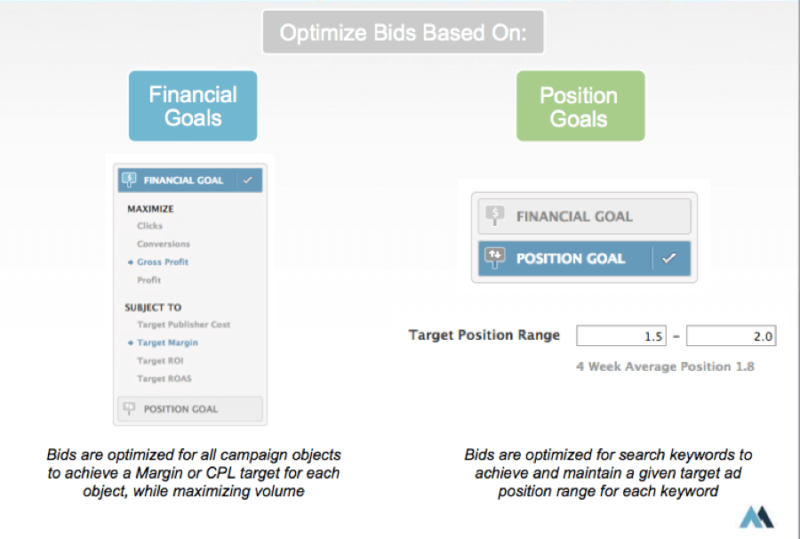Bidding & Optimization Strategies To Take Your Search Marketing Results To The Next Level
A majority of digital advertising budgets are put towards search, so the ability to be competitive in this space is critical. Columnist Matt Ackley discusses how you can maximize your ROI when creating your bidding strategy for paid search.

Recently, I’ve been talking about some very broad themes — audience marketing, programmatic, omnichannel — because I believe that’s where the market is heading. That being said, it would be shortsighted to overlook the fact that search is still the elephant in the room.
Search continues to be where the bulk of online advertising dollars are being spent, and it is still growing at a healthy clip. So for this column, we’re going to turn back the clock and talk search, specifically bidding and optimization strategies.
Search Is Too Damn Popular
Perhaps the number one problem with search marketing is that it’s just too popular. Competition for top spots on the search engine results page (SERP) is on the rise, and marketers have been increasingly concerned with standing out from the crowd in order to maximize their search ROI.
The key to success here is crafting and executing a strong bidding and optimization strategy.
Before You Do Anything, Put Your Business Objectives In Writing
Keeping up with the various bidding strategies available today can be overwhelming and confusing. There are many different levers you can adjust and different goals you can try to hit.
Recognizing there’s no such thing as a “one size fits all” bidding strategy, the first thing I ask of advertisers is to concretely define their business objectives before they do anything. You can’t optimize to a fuzzy goal.
Know The Pros And Cons Of Bidding Optimization Types
Manual bidding optimization is the most basic type of bid management strategy. In this scenario, advertisers typically apply simple bid boosts (or negative boosts) based on basic Boolean (if/then) logic. For example, an advertiser might boost bids for a particular keyword by 50% if it reaches a certain number of clicks, accumulates a certain number of conversions, or retargets a user who previously visited the advertiser’s website.
The benefit of manual bidding optimization is that it’s better than doing nothing. The downsides, though, are many. Manual bidding optimization will get very time-consuming if you’re working with any significant keyword volume. The optimization patterns are also very rudimentary.
On the other hand, algorithmic bidding is a more advanced method that provides advertisers with automation and control. Not surprisingly in this Moneyball day and age, algorithmic bidding is where it’s at. Algorithmic bidding takes into account all the basic factors you might consider with a manual bidding optimization strategy, but also helps advertisers more easily integrate complex business objectives including goals, constraints, and budgets.
However, the downside of algorithmic bidding is that it has a steeper learning curve, and you’ll need to work with some external tools to implement it.
At a high level, algorithmic bidding goals can be divided into position-based or financial goals. Let’s take a look at each of these in more detail.

Algorithmic bidding can be geared toward financial goals or position goals depending on the advertiser’s business objectives
Position-Based Bidding Goals
The simplest goal to optimize for is the search engine results page (SERP) position. Everyone wants to be first. It’s easy to show your CMO screenshots of your SERP listings and point to being in pole position as a measure of success.
But, while being in the top positions isn’t necessarily a bad thing, it’s important to remember that prime real estate on the SERP may not always be where keywords achieve maximum profit.
Financial-Based Bidding Goals
Marketers who want to achieve business objectives such as clicks, conversions, or profit will find bidding strategies based on efficiency to be best suited for their needs.
When calculating bids for a financial objective, the incremental cost of a bid should never be more than its incremental value. For example, if a marketer has a specific target CPA, she should check that the target CPA does not exceed her daily budget.
Maximize Your Returns By Considering The Following Four Factors In Your Bidding Strategy
1. Use Volume-Based Optimization To Get Incremental Value From Your Head Terms
Optimizing the ROI of a particular keyword is great, but not if you do so at the cost of another, more efficient keyword. Welcome to the world of opportunity costs!
Volume-based optimization helps account for these opportunity costs by ensuring that all the keywords in a particular set are optimized in concert with each other. The volume-based optimization approach is particularly geared toward driving gross profit. When there is an extra dollar to spend, volume-based optimization will determine which keyword(s) will provide the highest revenue in return.
Volume-based optimization is most effective when applied to the head terms of a given set of keywords. The large amount of historical data associated with head terms means that volume-based optimization can more accurately assess how much to invest in each keyword.
2. Use Budgeting Tools To Improve Your Budget Planning
Marketing would be easy if we didn’t have to worry about budgets. Unfortunately, for those of us not working at, say, Apple, budget constraints are a very real thing.
Success is defined within a particular constraint and accordingly, budget management and optimization is a critical component of success. In addition to planned activities, marketers must also be ready to deal with the unexpected, sudden budget cuts, product snafus, or new competitive activities that change the game.
Budget planning tools can be extremely helpful in looking beyond current spend and gaining insight into forecasted performance metrics including clicks, conversions, and revenue. In Marin, advertisers can leverage “What-If” analysis to determine where extra budget would deliver the greatest returns. This enables marketers to determine the best way to shift budget around to maximize performance.
While marketers can’t quite predict the future, innovations in the search advertising industry are making it easier than ever to make more informed bid decisions that are backed by a wealth of data.
3. Get To Know Your Audience
Ah, you may have guessed that I wouldn’t let a column slide by without mentioning audience marketing. Well, you were right!
Typically, marketers simply try to get as many eyeballs on their ads as possible. However, as we all know, not everyone has the same intent and interest, and the same message that resonates with Harry Styles is not going to resonate the same way with Betty White. Marketers who create experiences that meet an audience’s specific needs are more likely to capture the attention and business of those consumers.
You don’t have to get super complicated with your audience targeting. One simple way to leverage audience data is by using Remarketing Lists for Search Ads (RLSA). RLSAs use basic website behavioral data that any marketer has access to. There’s really no reason to not use it to enhance your targeting and optimization efforts.
4. Use Mobile Bid Adjustment Recommendations (MBARs) To Give Mobile the Special Treatment It Deserves
At this point, we’ve all succumbed to our new mobile overlords. The more apt question is, “How do we best serve them?”
As search marketers know, different keywords perform differently depending on device type. MBARs are a great way to boost visibility for the keywords that perform best on mobile devices. For example, marketers may choose to boost keywords related to locations or phone numbers to drive more mobile engagement. Conversely, marketers should use a negative mobile bid boost to decrease bidding for keywords that don’t perform well on mobile.
To highlight the difference that enabling bid boosts in campaigns can make, Marin found that clients who adjusted their bids for mobile had 10% higher CTR and a 2.5% lower CPC than those who did not.[1]
Hopefully these recommendations will help you get a better handle on optimizing your bidding strategies. However, they represent a drop in the bucket of what you can do.
[1] Marin Global Online Advertising Index: Q2 2013 vs. 2014 – 33% rise in boost client CTR vs a 23% rise for non-boost clients
Contributing authors are invited to create content for Search Engine Land and are chosen for their expertise and contribution to the search community. Our contributors work under the oversight of the editorial staff and contributions are checked for quality and relevance to our readers. The opinions they express are their own.
Related stories
